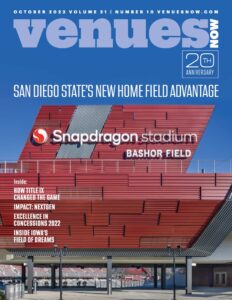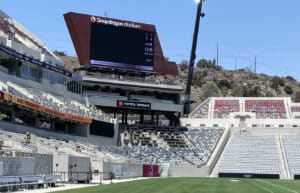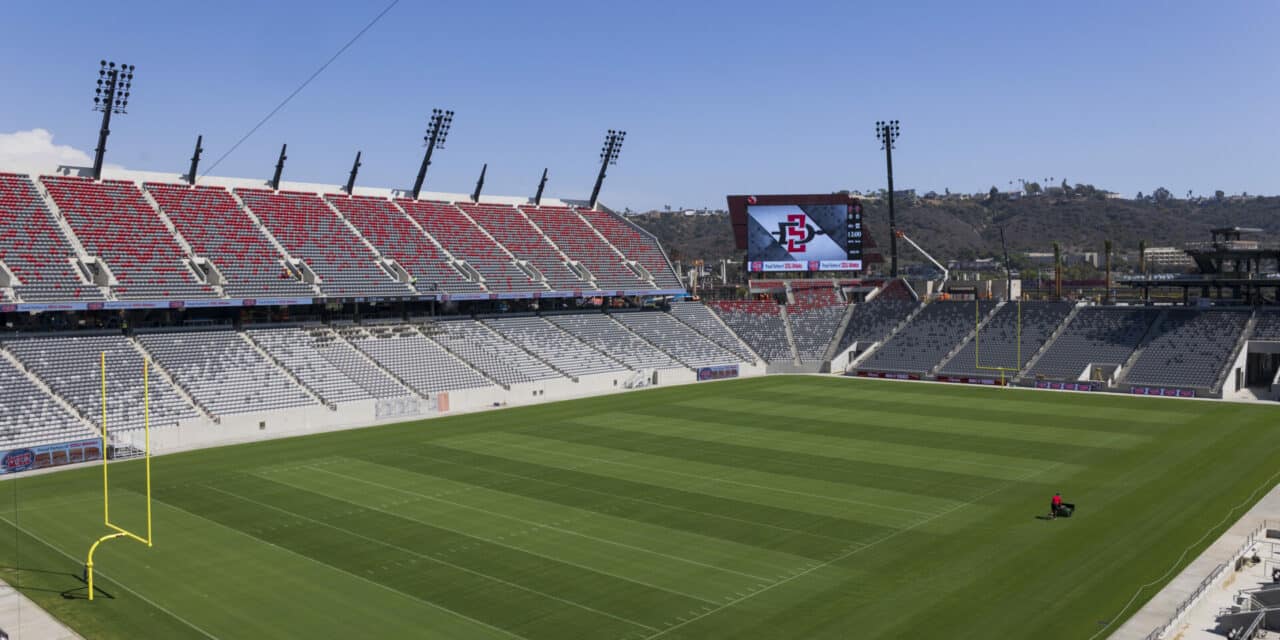HIKE: The $310 million, 35,000-seat Snapdragon Stadium at San Diego State University brings top-notch tech, premium seating and food service to college sports. (Katie Orchard / Courtesy San Diego State University)
College Sports Graduates To New High-Tech Social Heights
SAN DIEGO — San Diego State University’s Snapdragon Stadium takes the trend of developing venue social spaces to new heights.The $310 million, 35,000-seat college football stadium, which can be expanded to 40,000 for large events, debuted Sept. 3 when the SDSU Aztecs hosted the University of Arizona. The stadium’s first concert, with Jimmy Buffett and San Diego’s own Jason Mraz, is scheduled for Oct. 22.
The stadium is also home to the NWSL Wave, the San Diego Legion of Major League Rugby and could eventually house an MLS team.
The field itself is named for San Diego philanthropist Dianne Bashor, who gave $15 million to SDSU in 2019 toward construction of the new stadium.
SEE ALSO:
Local, Craft Flavor On Tap At Snapdragon Stadium
Busy-ness Is Good At Multi-Use Stadium
‘The Premier Football Product In Town’
The Gensler-designed stadium has several unique features.
At the push of a button that lowers and raises “garage doors,” the home locker room can be divided into two 40-person pods, with a breakout room in the middle, said SDSU Associate Athletic Director Derek Grice.
There are 16 suites across two levels, plus four Founders Suites that are double the size of the standard ones. Founders Suites go for $3.7 million for 15 years. For that, you get into every event. Those suites sold out in short order and there’s now a waiting list, Grice said.
Three other suites are reserved for university brass and there is also a 48-person Founders Club, for which seats are sold in pairs.
The seating bowl is steeply raked as it nears the field and a 5,000-seat student section in the north end zone area includes 2,900 safe standing seats of the kind used at Gensler-designed Banc of California Stadium, home of Major League Soccer’s LAFC.
Chunks of the old MLB Padres and NFL Chargers stadium, once named for local broadcaster Jack Murphy and later for Qualcomm, the San Diego tech company whose Snapdragon “system on a chip” suite of semiconductor products the stadium is named for, were used as pavers in an outdoor area where concerts for up to 1,000 people can be held. Some seats from the old stadium made their way into Snapdragon and a statue of Jack Murphy sits outside.
“There are lots of things throughout the building that pay homage to the old one,” said SDSU Athletic Director John David Wicker, who, like Grice, has a strong facility operations background and came to San Diego from Georgia Tech University.
Qualcomm Chief Marketing Officer Don McGuire said the naming rights deal will involve unique activations such as augmented reality at halftime shows, which is the kind of thing Snapdragon technology facilitates.
 McGuire said such “organic storytelling” opportunities at the venue are numerous for Qualcomm, a company still establishing its brand identity in 1997 when it acquired naming rights to Jack Murphy Stadium, which sat just east of where Snapdragon Stadium was built.
McGuire said such “organic storytelling” opportunities at the venue are numerous for Qualcomm, a company still establishing its brand identity in 1997 when it acquired naming rights to Jack Murphy Stadium, which sat just east of where Snapdragon Stadium was built.
“The buzz is just incredible,” McGuire said of the stadium’s impact in San Diego, where Qualcomm has 35,000 employees.
Getting the project done on schedule during a pandemic is a particular point of pride for those involved. It was the work of 1,200 people, extending from architects to consultants, engineers, contractors and laborers.
“We put other things on the backburner to push forward with a project of this size and magnitude,” Grice said. “We were extremely vigilant on the front end of the process to lock down prices early.”
That “kept it on deadline,” said Grice, who was involved in a major renovation to Bobcat Stadium at Texas State University, “but nothing of the magnitude of this.”
“It has not been easy. No one expected the depth of the supply chain issues to be what it was,” said Steve Chung, Gensler’s design director and partner. “We are nimble enough and broad enough in our practice to be able to stay connected with a whole network of vendors. If one tile is not available, we’re able to find a comparable one to try and get it in on time and make it work.”
Adam Millar, the stadium’s general manager for OVG360, said there were some isolated supply chain issues, but he expected them to be worse than they turned out to be.
“We have a great general contractor, Clark Construction, a large, powerful company,” Millar said. “They were able to acquire what they needed.”
Millar said his operations team would be ready for the first football game after a soft opening on Aug. 20 for an SDSU scrimmage for 15,000 season ticket holders and construction workers.
Having two athletic directors with venue operations experience has been invaluable, Millar said.
Grice said Snapdragon is more like a professional stadium than most collegiate venues.
“Our charge was to create pound for pound the best stadium experience in the industry,” he said. “It’s a truly multi-purpose stadium that can be utilized for international soccer, concerts, dirt shows, you name it,” he said, adding there’s “plenty of space for banquets, farmers markets, social networking events.”
In designing a stadium that could be used 365 days a year, Gensler concentrated on “organizing different premium spaces, different meeting spaces in such a way that you can scale up and do all kinds of university events,” Chung said.
“So, when you go there, you will see there is circulation connecting the field club to the west club to the Founders Suites,” he said. “That way, you can imagine academic symposia being held there, and then breakout sessions in the suites and networking afterwards either in the Piers or the Craft Gardens.”
“That really drove a lot of the thinking,” Chung said. “It challenged us to ensure those spaces functioned perfectly on game day but also would be a really desirable place for the university to come and do some of these conferences and events.”
Chung pointed to the (Sycuan) Piers above the south end zone as another signature design element. The intent was to develop a premium social football watching experience situated above the south end zone. A platform on the highest level of the Piers extends toward the field over the seating bowl, giving fans a bird’s-eye view of the action, if not a twinge of vertigo.
“It’s going to be something that people talk about,” Chung said. “We really learned a lot having come off Banc of California Stadium and the success of its Sunset Deck, a space that postgame becomes ‘the’ gathering spot to go and talk about the game and meet with people you’ve seen every week.”
The Piers’ field sight lines are designed to attract crowds during and after the game.
The space accommodates about 500 people, with excellent field views, but also has space to “roam around and get a premium experience that we think is unique.”
“What we’ve done is take what is traditionally undervalued real estate right in the corners above the lower bowl and have turned it into a destination,” Chung said.

GAME READY: Snapdragon Stadium had a soft opening with an Aug. 20 scrimmage, attended by 15,000 season ticket holders and construction workers, before San Diego State University took on Arizona on Sept. 3. (James Zoltak/Staff)
The stadium’s main concourse has ample space for food trucks to set up on the east side Craft Gardens.
“The way the street grid was planned allowed us to make the on-grade eastern concourse; we call it the Craft Gardens,” Chung said. “We’ve all been to stadiums where the concourse is at grade. We wanted to take that idea and absolutely make it a lush, landscaped indoor-outdoor beer garden experience. The width of the site allowed us to do that in an economical way, while allowing fans to have a little more elbow room at the same time.”
The overall result, Chung said, is a blending of spaces “to create a hyper-efficient football stadium along with a number of hospitality experiences that have been inspired by the city, whether it’s the beach communities or the indoor-outdoor kind of craft food and beverage vibe that’s in San Diego.”
Docks on the south side of the stadium make for easy setup and teardown.
Audio consultant WJHW did the sound system design, featuring Eastern Acoustics Works speakers.
Snapdragon Stadium is open to all promoters and will be booked by Jeff Olson, who came to the building from Fedex Forum, home of the NBA Memphis Grizzlies.
Millar expects the stadium to do 40 to 50 major events and another 50-75 special events in its first year of operation.
The student section seeks to recreate the home field advantage evident for SDSU basketball games at Viejas Arena, Chung said.
“Having been there and watching the culture of the show in their student section, we felt it was important to give a very specific home to it at Snapdragon Stadium,” he said. “So, in the north end zone you have safe standing seats, which you see in North American and European soccer.”
The stadium is part of a mixed-use development that extends from residential to retail and includes an Innovation District.
Directly south of the stadium will be over 1 million square feet of space to develop a large technology hub. As a firm, Snapdragon will be a key piece of that campus.
The SDSU main campus to the southeast has mostly Spanish colonial architecture, but that won’t be the case with the Mission Valley campus.
“From the get-go, the campus architect said this is a new part of campus and those types of aesthetics would not necessarily be an overlay,” Chung said. “There’s really a new forward-looking way to think about the campus and the architectural design.”
Are there elements of this stadium that we’re likely to see in projects in the future?
“This sports practice has the belief that one size absolutely doesn’t fit all. We want to customize every building for the marketplace, the donor base, the city itself,” he said. “We’re interested in this idea of blending the line between premium and general seating events and trying to figure out how to infuse these areas where it’s a win for the fan experience and a win for people who want to sponsor those spaces.”
There has been some talk of Snapdragon Stadium potentially expanding to 55,000 seats should an NFL team replace the departed Chargers one day.
“Anything’s possible, but there would have to be some demolition to get up to 55,000,” Chung said. “We wanted to make sure the people that come out for games have the right kind of experience and that means making sure you have the right kind of energy in the seating bowl, rather than leaving big gaps for what might happen someday.”
Said Wicker: “We built a building ready for MLS and ready for SDSU.”







